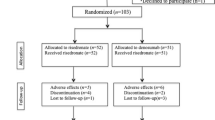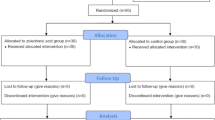Abstract
Summary
Forty-three patients who had undergone cementless THA were randomly assigned to receive no osteoactive drug or oral risedronate for 6 months. Postoperative decrease of BMD in the risedronate group was significantly lower than that seen in the control group in zones 1, 2, 3, 6, and 7.
Introduction
Proximal bone resorption around the femoral stem often has been observed after total hip arthroplasty (THA), could lead to late stem loosening. We previously reported the efficacy of etidronate on periprosthetic bone resorption after cementless THA. Recently risedronate is suggested to be effective for the prevention and treatment of for osteoporosis. The purpose of the present study was to evaluate the effects of risedronate on periprosthetic bone loss after cementless THA.
Methods
Forty-three patients who had undergone cementless THA were randomly assigned to receive no osteoactive drug (21 patients) or oral risedronate 2.5 mg/day (22 patients) for 6 months. Three patients were eliminated from the risedronate group because of dyspepsia. Periprosthetic bone mineral density (BMD) in seven regions of interest based on the zones of Gruen et al. was measured with dual energy X-ray absorptiometry at 3 weeks and 6 months postoperatively.
Results
At 6 months after surgery, postoperative decrease of BMD in the risedronate group was significantly lower than that seen in the control group in zones 1, 2, 3, 6, and 7 (p < 0.05, p < 0.01, p < 0.01, p < 0.05, and p < 0.05, respectively).
Conclusion
These outcomes suggested that risedronate might reduce the periprosthetic bone resorption after cementless THA.

Similar content being viewed by others
References
Engh CA Jr, Claus AM, Hopper RH Jr et al (2001) Long-term results using the anatomic medullary locking hip prosthesis. Clin Orthop 393:137–146
Xenos JS, Callaghan JJ, Heekin RD et al (1999) The porous-coated anatomic total hip prosthesis, inserted without cement. A prospective study with a minimum of ten years of follow-up. J Bone Jt Surg (Am) 81:74–82
Engh CA, Bobyn JD (1988) The influence of stem size and extent of porous coating on femoral bone resorption after primary cementless hip arthroplasty. Clin Orthop 231:7–28
Lord G, Marotte JH, Blanchard JP et al (1988) Cementless madreporic polarised total hip prostheses. A ten-year review of 2688 cases. Rev Chir Orthop Reparatrice Appar Mot 74:3–14
Bobyn JD, Mortimer ES, Glassman AH et al (1992) Producing and avoiding stress shielding. Laboratory and clinical observations of noncemented total hip arthroplasty. Clin Orthop 274:79–96
Engh CA, Massin P (1989) Cementless total hip arthroplasty using the anatomic medullary locking stem. Results using a survivorship analysis. Clin Orthop Relat Res 249:141–158
Black DM, Cummings SR, Karpf DB et al (1996) Randomised trial of effect of alendronate on risk of fracture in women with existing vertebral fractures. Fracture Intervention Trial Research Group. Lancet 348:1535–1541
Saag KG, Emkey R, Schnitzer TJ et al (1998) Alendronate for the prevention and treatment of glucocorticoid-induced osteoporosis. Glucocorticoid-Induced Osteoporosis Intervention Study Group. N Engl J Med 39:292–299
Harris ST, Watts NB, Genant HK et al (1999) Effects of risedronate treatment on vertebral and nonvertebral fractures in women with postmenopausal osteoporosis: a randomized controlled trial. Vertebral Efficacy With Risedronate Therapy (VERT) Study Group. JAMA 282:1344–1352
Reginster J, Minne HW, Sorensen OH et al (2000) Randomized trial of the effects of risedronate on vertebral fractures in women with established postmenopausal osteoporosis. Vertebral Efficacy with Risedronate Therapy (VERT) Study Group. Osteoporosis Int 11:83–91
Reid DM, Hughes RA, Laan RF et al (2000) Efficacy and safety of daily risedronate in the treatment of corticosteroid-induced osteoporosis in men and women: a randomized trial. European Corticosteroid-Induced Osteoporosis Treatment Study. J Bone Miner Res 15:1006–1013
McClung MR, Geusens P, Miller PD et al (2001) Effect of risedronate on the risk of hip fracture in elderly women. Hip Intervention Program Study Group. N Engl J Med 344:333–340
Yamaguchi K, Masuhara K, Yamasaki S et al (2003) Cyclic therapy with etidronate has a therapeutic effect against local osteoporosis after cementless total hip arthroplasty. Bone 33:144–149
Yamaguchi K, Masuhara K, Yamasaki S et al (2004) Effects of discontinuation as well as intervention of cyclic therapy with etidronate on bone remodeling after cementless total hip arthroplasty. Bone 35:217–223
Yamaguchi K, Masuhara K, Yamasaki S et al (2005) Efficacy of different dosing schedules of etidronate for stress shielding after cementless total hip arthroplasty. J Orthop Sci 10:32–36
Venesmaa PK, Kroger HP, Miettinen HJ et al (2001) Alendronate reduces periprosthetic bone loss after uncemented primary total hip arthroplasty; a prospective randomized study. J Bone Miner Res 16:2126–2131
Kim YH, Kim VE (1992) Results of the Harris-Galante cementless hip prosthesis. J Bone Jt Surg Br 74:83–87
Wixson RL, Stulberg SD, Mehlhoff M (1991) Total hip replacement with cemented, uncemented, and hybrid prostheses. A comparison of clinical and radiographic results at two to four years. J Bone Jt Surg (Am) 73:257–270
Gruen TA, McNeice GM, Amstutz HC (1979) “Mode of failure” of cemented stem-type femoral components. A radiographic analysis of loosening. Clin Orthop 141:17–27
Kiratli BJ, Checovich MM, McBeath AA et al (1996) Measurement of bone mineral density by dual-energy X-ray absorptiometry in patients with the Wisconsin hip, an uncemented femoral stem. J Arthroplasty 11:184–193
Nishii T, Sugano N, Masuhara K et al (1997) Longitudinal evaluation of time related bone remodeling after cementless total hip arthroplasty. Clin Orthop 339:121–131
Yamaguchi K, Masuhara K, Ohzono K et al (2000) Evaluation of periprosthetic bone-remodeling after cementless total hip arthroplasty. J Bone Jt Surg 82-A:1426–1431
Frenkel SR, Jaffe WL, Valle CD et al (2001) The effect of alendronate (Fosamax) and implant surface on bone integration and remodeling in a canine model. J Biomed Mater Res 58:645–650
Peter CP, Cook WO, Nunamaker DM et al (1996) Effect of alendronate on fracture healing and bone remodeling in dogs. J Orthop Res 14:74–79
Eberhardt C, Raussen W, Thiemann S et al (2005) Improved osseointegration and periprosthetic bone volume around cementless metal implants under bisphosphonate treatment. Z Orthop Ihre Grenzgeb 143:645–651
Arabmotlagh M, Rittmeister M, Hennigs T (2006) Alendronate prevents femoral periprosthetic bone loss following total hip arthroplasty: prospective randomized double-blind study. J Orthop Res 24:1336–1341
Kinov P, Tivchev P, Doukova P et al (2006) Effect of risedronate on bone metabolism after total hip arthroplasty: a prospective randomised study. Acta Orthop Belg 72:44–50
Fisher JE, Rogers MJ, Halasy JM et al (1999) Alendronate mechanism of action: geranylgeraniol, an intermediate in the mevalonate pathway, prevents inhibition of osteoclast formation, bone resorption, and kinase activation in vitro. Proc Natl Acad Sci USA 96:133–138
Wilkinson JM, Stockley I, Peel NF et al (2001) Effect of pamidronate in preventing local bone loss after total hip arthroplasty: a randomized, double-blind, controlled trial. J Bone Miner Res 16:556–564
Lichtenberger LM, Romero JJ, Gibson GW et al (2000) Effect of bisphosphonates on the surface hydrophobicity and phosphatidylcholine concentration of rodent gastric mucosa. Dig Dis Sci 45:1792–1801
Lanza F, Schwartz H, Sahba B et al (2000) An endoscopic comparison of the effects of alendronate and risedronate on upper gastrointestinal mucosae. Am J Gastroenterol 95:3112–3117
Fogelman I, Moreland L, Woodson G et al (2000) Gastrointestinal side effects and endoscopic findings similar between risedronate and placebo-treated patients. Osteoporos Int 11(Suppl 2):S179
Hosking D, Beckman R, Glowinski J et al (2000) Similar gastrointestinal side effects and endoscopic findings between risedronate and placebo-treated patients. J Bone Miner Res 15:S428
Delaney MF, Hurwitz S, Shaw J et al (2003) Bone density changes with once weekly risedronate in postmenopausal women. J Clin Densitom 6:45–50
Palomba S, Orio F Jr, Manguso F et al (2005) Efficacy of risedronate administration in osteoporotic postmenopausal women affected by inflammatory bowel disease. Osteoporos Int 14:1141–1149
Brown JP, Kendler DL, McClung MR et al (2002) The efficacy and tolerability of risedronate once a week for the treatment of postmenopausal osteoporosis. Calcif Tissue Int 71:103–111
Ilter E, Karalok H, Tufekci EC et al (2006) Efficacy and acceptability of risedronate 5 mg daily compared with 35 mg once weekly for the treatment of postmenopausal osteoporosis. Climacteric 9:129–134
Acknowledgements
The authors wish to gratefully acknowledge Masazumi Notou for technical assistance.
This study is based on data collected in Osaka Kosei-Nenkin Hospital.
Author information
Authors and Affiliations
Corresponding author
Rights and permissions
About this article
Cite this article
Yamasaki, S., Masuhara, K., Yamaguchi, K. et al. Risedronate reduces postoperative bone resorption after cementless total hip arthroplasty. Osteoporos Int 18, 1009–1015 (2007). https://doi.org/10.1007/s00198-007-0339-7
Received:
Accepted:
Published:
Issue Date:
DOI: https://doi.org/10.1007/s00198-007-0339-7




